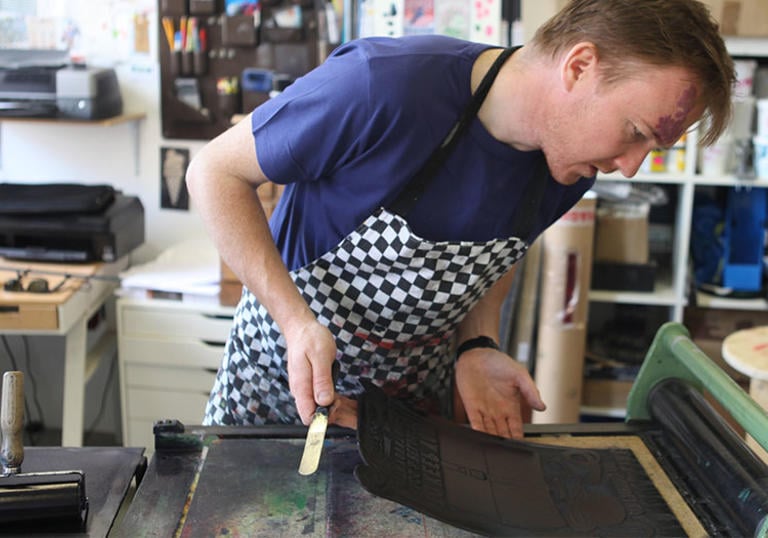After training as a textile designer at Middlesex University and working in the clothing industry for 10 years, James changed direction to illustration and printing on paper instead of fabric.
How do you bring an idea or moment of inspiration into a design? Can you describe your creative process?
‘All good design starts off with a good solid idea, once you have this, the design process should flow. There is no point slaving over a bad idea.’
What does a typical day (if there is one…!) look like in your studio?
‘My cycle to work through the Olympic Park is brilliant, I live on one side and work on the other so hardly have to use roads, it’s an entire journey of cycle paths, river and canal paths and green space. A good start to the day. When I get to my studio it’s usually a day of printing, packing wholesale and online orders, visits to the Post Office, paper work, replying to emails or ordering supplies. All this keeps me very busy and tends to fill my days without leaving me the time to sit down and be creative. Actually sitting down to design is a luxury and something that I tend to do in my home office where I feel I can concentrate better and where I am more inspired because I have lots of lovely reference books to thumb through and a lovely garden to stare out of the window at.’
I use traditional techniques to make my prints…The computer is just another tool.
How do you create your prints? Do you still use traditional hand rendered methods or do you use digital technology at all?
‘I use traditional techniques to make my prints, I cut the lino by hand and each print is hand printed on an old Stephenson Blake proofing press. I use a computer to design everything, everything is drawn by hand with vector points on a computer rather than with a pencil on paper. The computer is just another tool. I start off with a pencil to sketch ideas and then move onto the computer to achieve the level of precision that I require of my lines.’
Your Barbican commission takes its inspiration from music with a range called ‘Visual Music’ – what drew you to this theme?
‘Visual Music’ appealed to the decorative, textile/pattern designer in me. Music is such a joy but I am so unmusical, to me a musician is like a magician, I really don’t understand how they do it. So the chance to represent the flow, repetition, rhythm and balance of music, visually, was a joy and one that I could understand.’
What other iterations did you explore when creating your Barbican inspired print?
‘Both ‘TRUMPET’ and ‘REVERB’ were designed so that the two colour print was printed from one piece of lino. The first colour was printed (gold) and then the lino was rotated 180 degrees to print the second colour (either blue or red). This process takes a lot of working out to ensure everything works technically and visually, I also had the added element of having to make the design work in repeat so technically quite a challenge. I like to design in this way though, having strict limitations to work within.’
Do you have any advice for artists/designers looking to work in print making?
‘Playing and having fun is a good way to learn, exploration to gain an in-depth understanding of the process. No need to spend lots of money on expensive kit, open access studios are a great place to print and learn from watching other people.’

